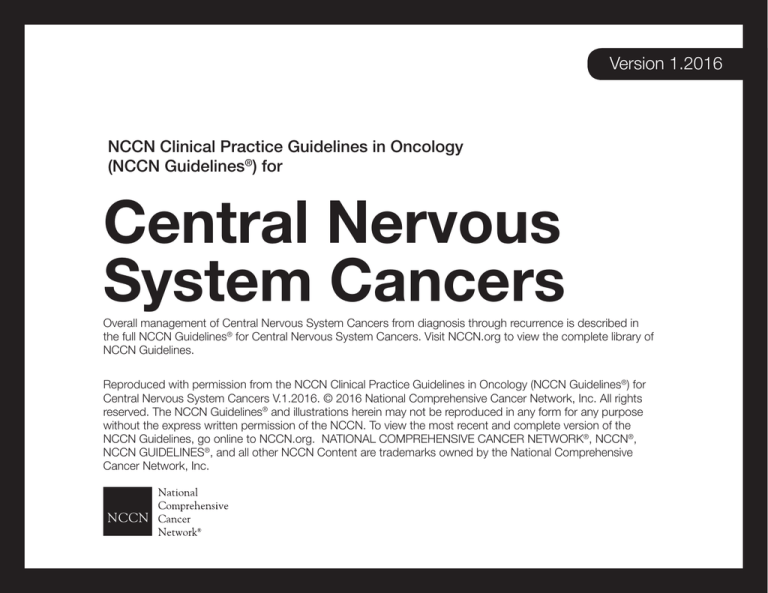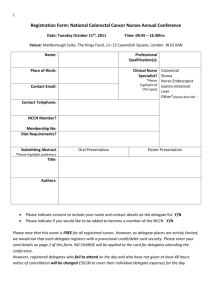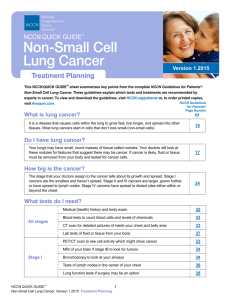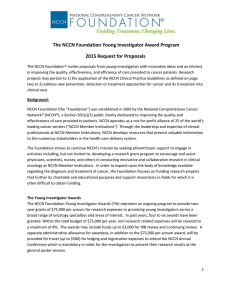
Version 1.2016
NCCN Clinical Practice Guidelines in Oncology
(NCCN Guidelines®) for
Central Nervous
System Cancers
Overall management of Central Nervous System Cancers from diagnosis through recurrence is described in
the full NCCN Guidelines® for Central Nervous System Cancers. Visit NCCN.org to view the complete library of
NCCN Guidelines.
Reproduced with permission from the NCCN Clinical Practice Guidelines in Oncology (NCCN Guidelines®) for
Central Nervous System Cancers V.1.2016. © 2016 National Comprehensive Cancer Network, Inc. All rights
reserved. The NCCN Guidelines® and illustrations herein may not be reproduced in any form for any purpose
without the express written permission of the NCCN. To view the most recent and complete version of the
NCCN Guidelines, go online to NCCN.org. NATIONAL COMPREHENSIVE CANCER NETWORK®, NCCN®,
NCCN GUIDELINES®, and all other NCCN Content are trademarks owned by the National Comprehensive
Cancer Network, Inc.
® |
Central
Nervous
System
Cancers
Version
1.2016
Guidelines Index
NCCN
Guidelines
Version
1.2016 | NCCN Guidelines NCCN
Table of Contents
Discussion
Anaplastic Gliomasa/Glioblastoma
MGMTn PROMOTOR
STATUS
GLIOBLASTOMA
PATHOLOGYd
Methylated
Standard brain RT k + concurrent temozolomide
and adjuvant temozolomide + alternating
electric field therapym,p,q,r
or
Standard brain RT k + concurrent temozolomide
and adjuvant temozolomide (category 1)m,p,q
Unmethylated
or
indeterminate
Standard brain RTk + concurrent temozolomides
and adjuvant temozolomides + alternating
electric field therapym,p,q,r
or
Standard brain RT k + concurrent temozolomides
and adjuvant temozolomide (category 1)m,p,q,s
or
Standard brain RT alonek
Good
performance
status
(KPS ≥60)
Age ≤70 y
Glioblastomaj
± carmustine
(BCNU)
wafer o
Poor
performance
status (KPS <60)
Age >70 y
ADJUVANT TREATMENT
FOLLOW-UPb
MRI 2–6 wk
after RT,
then every
2–4 mo
for 2–3 y,
then less
frequently
See
Recurrence
(GLIO-5)
Standard or hypofractionated brain RT k
or
Temozolomidet
or
Palliative/Best supportive care
See GLIO-4
aThis
pathway includes the classification of mixed anaplastic oligoastrocytoma
(AOA), anaplastic astrocytoma (AA), anaplastic oligodendroglioma (AO), and
other rare anaplastic gliomas.
bSee Principles of Brain and Spine Tumor Imaging (BRAIN-A).
dSee Principles of Brain Tumor Pathology (BRAIN-F).
jThis pathway also includes gliosarcoma.
kSee Principles of Brain and Spinal Cord Tumor Radiation Therapy (BRAIN-C).
mSee Principles of Brain and Spinal Cord Tumor Systemic Therapy (BRAIN-D).
nMGMT= O6-methylguanine-DNA methyltransferase.
oTreatment with carmustine wafer, reirradiation, or multiple prior systemic
therapies may impact enrollment in some adjuvant clinical trials.
pCombination of agents may lead to increased toxicity or radiographic changes.
qBenefit of treatment with temozolomide for glioblastomas beyond 6 months is
unknown. The optimal duration of treatment with temozolomide for anaplastic
astrocytoma is unknown.
rAlternating electric field therapy is only an option for patients with
supratentorial disease.
sClinical benefit from temozolomide is likely to be lower in patients whose
tumors lack MGMT promotor methylation.
tTemozolomide monotherapy is only recommended if tumor is MGMT promotor
methylated.
Note: All recommendations are category 2A unless otherwise indicated.
Clinical Trials: NCCN believes that the best management of any patient with cancer is in a clinical trial. Participation in clinical trials is especially encouraged.
Version 1.2016, 07/25/16 © National Comprehensive Cancer Network, Inc. 2016, All rights reserved. The NCCN Guidelines® and this illustration may not be reproduced in any form without the express written permission of NCCN®.
Visit NCCN.org to view the complete library of NCCN Guidelines.
GLIO-3
® |
Central
Nervous
System
Cancers
Version
1.2016
Guidelines Index
NCCN
Guidelines
Version
1.2016 | NCCN Guidelines NCCN
Table of Contents
Discussion
Anaplastic Gliomasa/Glioblastoma
GLIOBLASTOMA
PATHOLOGYd
MGMT PROMOTOR
STATUSn
Methylated
Good
performance
status (KPS ≥60)
Age >70 y
(Glioblastomaj
± carmustine
(BCNU) wafer o)
Unmethylated
or
indeterminate
Poor performance
status (KPS <60)
ADJUVANT TREATMENT
Temozolomide
or
Hypofractionated brain RT alonek (category 1)
or
Hypofractionated brain RTk
+ concurrent and adjuvant temozolomidem,p,q
or
Standard RTk + concurrent temozolomide and adjuvant
temozolomide + alternating electric field therapym,p,q,r
or
Standard RTk + concurrent temozolomide and adjuvant
temozolomidem,p,q
Hypofractionated brain RT alonek (category 1)
or
Standard RTk + concurrent temozolomides and adjuvant
temozolomides + alternating electric field therapym,p,q,r
or
Standard RTk + concurrent temozolomides and
adjuvant temozolomidem,p,q,s
FOLLOW-UPb
MRI 2–6 wk
after RT, then
every 2–4 mo
for 2–3 y, then
less frequently
See
Recurrence
(GLIO-5)
Hypofractionated brain RT alonek
or
Temozolomidet
or
Palliative/Best supportive care
aThis
pathway includes the classification of mixed anaplastic
oligoastrocytoma (AOA), anaplastic astrocytoma (AA), anaplastic
oligodendroglioma (AO), and other rare anaplastic gliomas.
bSee Principles of Brain and Spine Tumor Imaging (BRAIN-A).
dSee Principles of Brain Tumor Pathology (BRAIN-F).
jThis pathway also includes gliosarcoma.
kSee Principles of Brain and Spinal Cord Tumor Radiation
Therapy (BRAIN-C).
mSee Principles of Brain and Spinal Cord Tumor Systemic
Therapy (BRAIN-D).
nMGMT= O6-methylguanine-DNA methyltransferase.
oTreatment
with carmustine wafer, reirradiation, or multiple prior systemic therapies may
impact enrollment in some adjuvant clinical trials.
pCombination of agents may lead to increased toxicity or radiographic changes.
qBenefit of treatment with temozolomide for glioblastomas beyond 6 months is unknown. The
optimal duration of treatment with temozolomide for anaplastic astrocytoma is unknown.
rAlternating electric field therapy is only an option for patients with supratentorial disease.
sClinical benefit from temozolomide is likely to be lower in patients whose tumors lack
MGMT promotor methylation.
tTemozolomide monotherapy is only recommended if tumor is MGMT promotor methylated.
Note: All recommendations are category 2A unless otherwise indicated.
Clinical Trials: NCCN believes that the best management of any patient with cancer is in a clinical trial. Participation in clinical trials is especially encouraged.
Version 1.2016, 07/25/16 © National Comprehensive Cancer Network, Inc. 2016, All rights reserved. The NCCN Guidelines® and this illustration may not be reproduced in any form without the express written permission of NCCN®.
Visit NCCN.org to view the complete library of NCCN Guidelines.
GLIO-4
| Version
Guidelines Index
Central
Nervous
System
Cancers
1.2016
NCCN
Guidelines
Version
1.2016 | NCCN Guidelines®NCCN
Anaplastic Gliomasa/Glioblastoma
RECURRENCE
TREATMENT
Diffuse or
multiple
Palliative/Best supportive care if poor
performance status
or
Systemic chemotherapym,w
or
Surgery for symptomatic, large lesion
or
Consider alternating electric field
therapy for glioblastoma (category 2B)
Recurrent
disease u,v for:
• Anaplastic
oligodendroglioma
• Anaplastic
oligoastrocytoma
• Anaplastic
astrocytoma
• Anaplastic gliomas
• Glioblastoma
Resectable
Local
Resection
+ carmustine
(BCNU) wafer o
Resection without
carmustine (BCNU)
wafer
Brain
MRIb,i
Palliative/Best supportive care if poor
performance status
or
Systemic chemotherapym,w
or
Consider reirradiation (category 2B) k,x
or
Consider alternating electric field
therapy for glioblastoma (category 2B)
Table of Contents
Discussion
Palliative/Best
supportive care
See NCCN
Guidelines For
Palliative Care
Unresectable
aThis
pathway includes the classification of mixed anaplastic oligoastrocytoma (AOA),
anaplastic astrocytoma (AA), anaplastic oligodendroglioma (AO), and other rare
anaplastic gliomas.
bSee Principles of Brain and Spine Tumor Imaging (BRAIN-A).
iPostoperative brain MRI within 24–72 hours after surgery.
kSee Principles of Brain and Spinal Cord Tumor Radiation Therapy (BRAIN-C).
mSee Principles of Brain and Spinal Cord Tumor Systemic Therapy (BRAIN-D).
oTreatment with carmustine wafer, reirradiation, or multiple prior systemic therapies
may impact enrollment in some adjuvant clinical trials.
uConsider MR spectroscopy, MR perfusion, or brain PET to rule out radiation necrosis.
vWithin
the first 3 months after completion of RT and concomitant
temozolomide, diagnosis of recurrence can be indistinguishable from
pseudoprogression on neuroimaging. With pseudoprogression, stabilization
or improvement should be expected within 3 mo of the end of radiotherapy.
wAnaplastic oligodendrogliomas have been reported to be especially sensitive
to chemotherapy. Chemotherapy using temozolomide or nitrosourea-based
regimens may be appropriate.
xEspecially if long interval since prior RT and/or if there was a good response
to prior RT.
Note: All recommendations are category 2A unless otherwise indicated.
Clinical Trials: NCCN believes that the best management of any patient with cancer is in a clinical trial. Participation in clinical trials is especially encouraged.
Version 1.2016, 07/25/16 © National Comprehensive Cancer Network, Inc. 2016, All rights reserved. The NCCN Guidelines® and this illustration may not be reproduced in any form without the express written permission of NCCN®.
GLIO-5
The National Comprehensive Cancer Network® (NCCN®) appreciates that supporting companies recognize NCCN’s need for autonomy in the
development of the content of NCCN resources. All NCCN Guidelines are produced completely independently. NCCN Guidelines are not intended to
promote any specific therapeutic modality. The distribution of this flash card is supported by Novocure, Inc.
OPT-658
© 2016 National Comprehensive Cancer Network
GL-N-0751-1016




